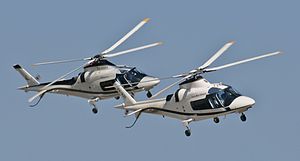AgustaWestland AW109
| AW109 | |
|---|---|
 |
|
| Two civilian AW109 helicopters at Rand Airport Air Show 2011 | |
| Role | SAR/utility helicopter |
| Manufacturer |
Agusta AgustaWestland |
| First flight | 4 August 1971 |
| Introduction | 1976 |
| Status | Active service/In production |
| Primary users |
Italian Army Belgian Air Component REGA (Swiss Air Rescue) Royal New Zealand Air Force |
| Produced | 1971–present |
| Unit cost |
US$ 6.3 million
|
| Variants | AgustaWestland AW109S Grand |
| Developed into | AgustaWestland AW119 |
The AgustaWestland AW109 is a lightweight, twin-engine, eight-seat multi-purpose helicopter built by the Italian manufacturer Leonardo-Finmeccanica (formerly AgustaWestland, merged into the new Finmeccanica since 2016). The rotorcraft had the distinction of being the first all-Italian helicopter to be mass-produced.
Developed as the A109 by Agusta, it originally entered service in 1976 and has since been used in various roles, including light transport, medevac, search-and-rescue, and military roles. The AW109 has been in continuous production for 40 years. The AgustaWestland AW119 is a derivative of the AW109, the main difference being that it is powered only by a single engine instead.
In the late 1960s, Agusta designed the A109 originally as a single-engine commercial helicopter. However, it was soon realised that a twin-engine design was needed and it was re-designed in 1969 with two Allison 250-C14 turboshaft engines. A projected military version (the A109B) was considered early on but Agusta initially chose not to pursue immediate development, instead concentrating on the eight-seat A109C version. The first of three prototypes made its maiden flight on 4 August 1971. The A109's flight testing phase was prolonged, this was due in part to the discovery of dynamic instability which took a year to resolve via a modified transmission design; this led to the first production aircraft being completed almost four years later in April 1975. On 1 June 1975, certification for visual flight rules (VFR) upon the A109 was received from the Federal Aviation Administration (FAA).
In 1976, deliveries of production A109 to customers began. Advantages over the then-market leading Bell 206 were the A109's superior speed, twin-engine redundancy, and greater seating capacity. In 1975, Agusta returned again to the possibility of a military version, thus a series of trials were carried out between 1976 and 1977 using a total of five A109As outfitted with Hughes Aircraft-built TOW missiles. Two military versions emerged from this program, one was intended for light attack/close support missions and the other for shipboard operations.
...
Wikipedia
